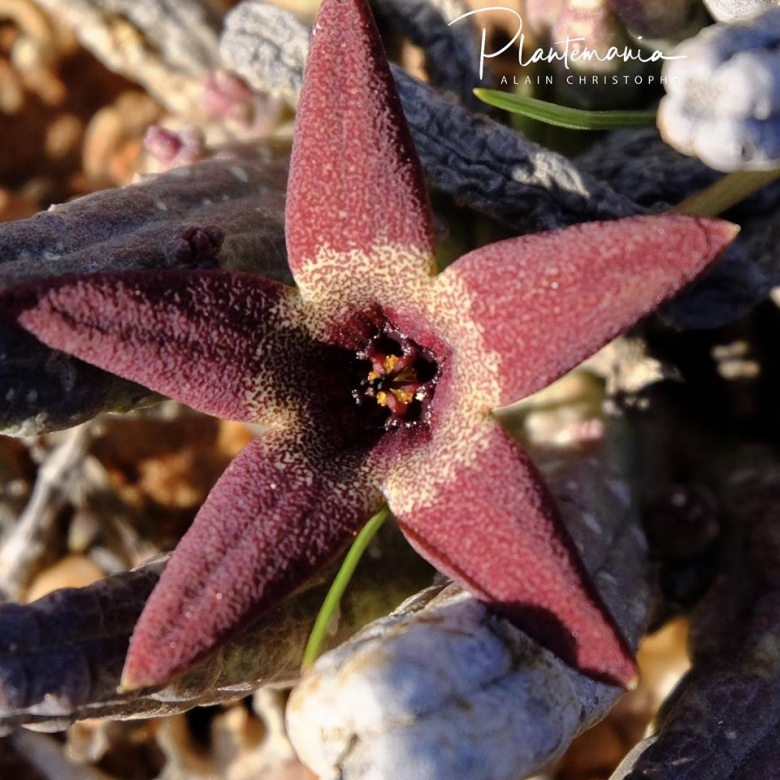Accepted Scientific Name: Tromotriche aperta (Masson) Bruyns
S. African J. Bot. 61: 208 1995

Stisseria aperta (Tromotriche aperta) Photo by: © Plantemania
In habitat.
Origin and Habitat: Tromotriche apertaSN|30579]]SN|30579]] is found in the Northern Cape, South Africa, it also occurs in Namibia, but as it is only known from a single locality (west of Rosh Pinah near Obib).
Altitude range: 300–500 metres above sea level.
Habitat and Ecology: This species grows in stony flats among scattered low shrubs. Flowering time: summer to autumn (Dececember to June) It is not threatened.
Synonyms:
Description: Tromotriche apertaSN|30579]]SN|30579]] is a small compact clump-forming succulent to 20 cm across and produces really stunning flowers, inside white or yellowish with red-brown between then usually uniformly beige or brown or red-brown towards tips of lobes, marked with small impressed irregular purple-brown lines and dots.
Stems: Somewhat spreading to erect with occasional horizontal stems at the base, 3-10 cm long, 6–15 mm in diameter, very obtusely 4-angled, glabrous, light glaucous green, scarcely toothed.
Inflorescences: 1–2 per stem mainly near base, peduncle to 5 mm long, pedicel 6-14 cm long, 2–3 mm in diameter, mostly prostrate with upturned apex.
Flowers: Apparently solitary. Sepals 2-3 mm long, ovate, acute, glabrous. Corolla shallowly campanulate 30–40mm in diameter, quite glabrous, inside white or yellowish with red-brown between then usually uniformly beige or brown or red-brown towards tips of lobes, reticulately rugulose.
Tube about 5–8mm long and 10-12 mm in diameter, cup- or somewhat funnel-shaped, densely papillate and usually purple-brown at the basal half within, whitish or yellowish white on rugosities, marked (sometimes labyrinthically) with small impressed irregular purple-brown lines and dots. Lobes ascending to very spreading, 10-14(-25) mm long, 7-9(-10) mm broad, ovate-oblong to deltate, convex above, acute, with more or less reflexed margins, rugulose and with 3 impressed nerves on the inner face, apparently purplish-brown or olive-brown, eciliate. Corona about 6×5mm broad, yellow-brown to red or blackish, raised on short stipe. The outer lobes (1mm long), usually fused into a cup may consist of five small lobes and always have a crenulate margin, they are closely pressed to sides of tube and apparently whitish. The inner lobes rise up in the centre and are much exceeding anthers, produced above them, 3–4 mm long, linear-filiform or very slightly clavate (slightly thickened towards tips), adpressed to backs of anthers then connivent-erect in small column and arc slightly towards the apices, there is sometimes an irregularly tuberculate dorsal crest near base confluent with outer lobes, dark purple-brown.
Bibliography: Major references and further lectures
1) N. E. Brown,“Flora Capensis”, Vol 4, 1909
2) Hall, A.V., De Winter, M., De Winter, B. and Van Oosterhout, S.A.M. 1980. "Threatened plants of southern Africa". South African National Scienctific Programmes Report 45. CSIR, Pretoria.
3) Hilton-Taylor, C. 1996. "Red data list of southern African plants". Strelitzia 4. South African National Botanical Institute, Pretoria.
4) Raimondo, D., von Staden, L., Foden, W., Victor, J.E., Helme, N.A., Turner, R.C., Kamundi, D.A. and Manyama, P.A. 2009. "Red List of South African Plants". Strelitzia 25. South African National Biodiversity Institute, Pretoria.
5) Victor, J.E. 2005. Tromotriche aperta (Masson) Bruyns. National Assessment: Red List of South African Plants version 2017.1. Accessed on 2018/11/18
6) P.V. Bruyns, “A re-assessment of the genera Tridentea Haw. and Tromotriche Haw.” S.-Afr. Tydskr. Plantk. 61(4): 180-208, 1995. Web: https://core.ac.uk/download/pdf/82745949.pdf
7) P.V. Bruyns, “The Apocynaceae of Namibia”, Strelitzia 34. South African National Biodiversity Institute, Pretoria. 2014










